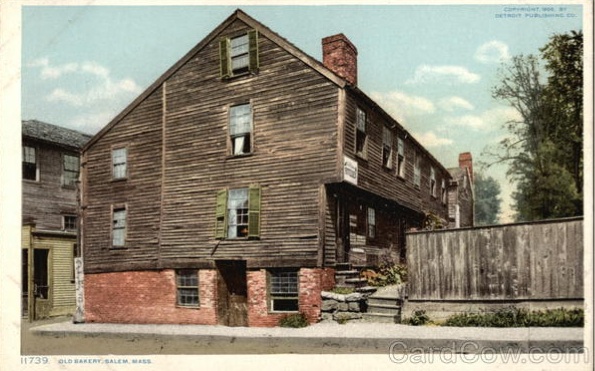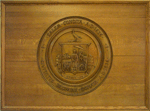Hooper Hathaway House: Difference between revisions
No edit summary |
|||
| (11 intermediate revisions by 2 users not shown) | |||
| Line 9: | Line 9: | ||
"The Hooper - Hathaway House is a building that was rescued through the combined efforts of Caroline Emmerton and the Society for the Preservation of New England Antiquities. Miss Emmerton purchased it and moved it from Washington Street to its present location in 1911 when it was threatened with destruction. It has been heavily restored in the Colonial Revival Style, and its wonderfully nostalgic diamond pane windows are a 1911 creation, but it still retains some very exciting Jacobian details. For instance, on the eastern overhang you can see an excellent example of first period projecting timbers. Normally, these exposed beams that hold the floor joists would simply be rounded off. In this case, the builders spent time creating a cyma, or double curved profile, and added a scalloped fillet, or banding." | "The Hooper - Hathaway House is a building that was rescued through the combined efforts of Caroline Emmerton and the Society for the Preservation of New England Antiquities. Miss Emmerton purchased it and moved it from Washington Street to its present location in 1911 when it was threatened with destruction. It has been heavily restored in the Colonial Revival Style, and its wonderfully nostalgic diamond pane windows are a 1911 creation, but it still retains some very exciting Jacobian details. For instance, on the eastern overhang you can see an excellent example of first period projecting timbers. Normally, these exposed beams that hold the floor joists would simply be rounded off. In this case, the builders spent time creating a cyma, or double curved profile, and added a scalloped fillet, or banding." | ||
According to the ''National Historic Landmark Nomination'' papers for the Gables: | |||
"The Hooper-Hathaway House, an important Postmedieval building in its own right, faces east toward the House of the Seven Gables across the garden. Built c. 1682 at 23 Washington Street in Salem, the house was on the point of being torn down in 1911 when, at the urging of William Sumner Appleton, founder of the Society for the Preservation of New England Antiquities (SPNEA), Caroline Emmerton purchased the house and moved it to the grounds of the House of the Seven Gables to provide additional space for the settlement house programs. | |||
The building was moved in three pieces representing its three building campaigns: the original structure, now the southern end, a single room plan house with chimney bay on the right-hand end; a file of rooms added to the other side of the chimney by 1784; and a two story lean-to with a Beverly jog built across the rear. | |||
Once moved, the Hooper-Hathaway House was restored by Joseph Everett Chandler, who brought the original part back to a Postmedieval appearance inside and out. In the process he exposed and preserved some of the most important and unique examples of seventeenth-century decorative treatment of timbers to survive in New England." | |||
[[Image:OldBakery.jpg]] | [[Image:OldBakery.jpg]] | ||
| Line 19: | Line 25: | ||
*Postcard courtesy of '''CardCow.com''' | *Postcard courtesy of '''CardCow.com''' | ||
* | *Vertical File in Salem Collection - '''Chandler, Joseph''' | ||
* | *[https://7gables.org/archives-category/hooper-hathaway-house/ Hooper Hathaway House] House of the Seven Gables website | ||
*[http://evergreen.noblenet.org/eg/opac/record/2259451?locg=63 Visitor's Guide to Salem] 1916 ed., p.158 | |||
*[http:// | *[http://salem.noblenet.org/eg/opac/record/1824024?locg=63 History of Salem Massachusetts] Sidney Perley, Vol. 3, p.178-181 | ||
* | *"Old bakery, now at House of Seven Gables Settlement, is ancient relic" ''Salem Evening News'', July 15, 1943, p.? | ||
*[http:// | *[http://evergreen.noblenet.org/eg/opac/record/2057293?locg=63 Nicknames and Neighborhoods] by F. Gannon, p. 27 | ||
Latest revision as of 13:14, 22 February 2024
Hooper Hathaway House (built 1683)
Now sited on the property of the House of the Seven Gables, this house was built in 1683, by Benjamin Hooper and was moved from 23 Washington Street. It was known as the Old Bakery when at the Washington Street location, as it was used as a bakery for years. George Hathaway was the baker when the old structure sat at 23 Washington Street. According to Gannon is his book Nicknames and Neighborhoods, "it was an old Salem custom to fetch pots of beans to the bake shop on Saturday, to linger a while to talk over news and gossip."
According to the Seven Gables website:
"The Hooper - Hathaway House is a building that was rescued through the combined efforts of Caroline Emmerton and the Society for the Preservation of New England Antiquities. Miss Emmerton purchased it and moved it from Washington Street to its present location in 1911 when it was threatened with destruction. It has been heavily restored in the Colonial Revival Style, and its wonderfully nostalgic diamond pane windows are a 1911 creation, but it still retains some very exciting Jacobian details. For instance, on the eastern overhang you can see an excellent example of first period projecting timbers. Normally, these exposed beams that hold the floor joists would simply be rounded off. In this case, the builders spent time creating a cyma, or double curved profile, and added a scalloped fillet, or banding."
According to the National Historic Landmark Nomination papers for the Gables:
"The Hooper-Hathaway House, an important Postmedieval building in its own right, faces east toward the House of the Seven Gables across the garden. Built c. 1682 at 23 Washington Street in Salem, the house was on the point of being torn down in 1911 when, at the urging of William Sumner Appleton, founder of the Society for the Preservation of New England Antiquities (SPNEA), Caroline Emmerton purchased the house and moved it to the grounds of the House of the Seven Gables to provide additional space for the settlement house programs. The building was moved in three pieces representing its three building campaigns: the original structure, now the southern end, a single room plan house with chimney bay on the right-hand end; a file of rooms added to the other side of the chimney by 1784; and a two story lean-to with a Beverly jog built across the rear. Once moved, the Hooper-Hathaway House was restored by Joseph Everett Chandler, who brought the original part back to a Postmedieval appearance inside and out. In the process he exposed and preserved some of the most important and unique examples of seventeenth-century decorative treatment of timbers to survive in New England."
See Also
- Postcard courtesy of CardCow.com
- Vertical File in Salem Collection - Chandler, Joseph
- Hooper Hathaway House House of the Seven Gables website
- Visitor's Guide to Salem 1916 ed., p.158
- History of Salem Massachusetts Sidney Perley, Vol. 3, p.178-181
- "Old bakery, now at House of Seven Gables Settlement, is ancient relic" Salem Evening News, July 15, 1943, p.?
- Nicknames and Neighborhoods by F. Gannon, p. 27

